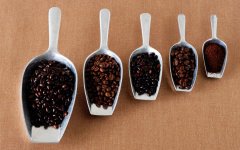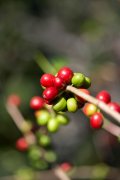Since when did coffee become popular in China? coffee is the earliest coffee in China.
Coffee has long captured the hearts of people all over the world. But when did it begin to enter the life of human society? Unfortunately, like most food and drink, so far no one has found out. According to the legends left by the ancient belt, we can only imagine the first encounter between people and coffee. Among the many legends about how humans discovered coffee, the most widely spread and accepted stories are the following two stories.
History chapter
The Story of the Arab Shepherd Adi
In the 6th century AD, a shepherd named Adi lived on the Ethiopian plateau. One day he drove goats to the new prairie to graze, and accidentally found that the goats were so excited that they could not sleep even when they returned to the sheepfold. The troubled Adi went to a nearby monastery for advice. After investigation, the abbot found that the goat had eaten the red fruit like a cherry on a shrub. After many attempts, the dean finally made the red fruit into a soup, and when he drank the drink, he was also unable to sleep that night. So he came up with a good idea to try to get the monks who dozed off in the evening service to drink this drink, and the experiment worked very well. From then on, the monks drank the red fruit whenever they had something to do at night.
The story of the Muslim monk Omaru
Shack, a Muslim monk. Omaru was exiled from Mocha in Arabia to Osab for violating clan rules. When he wandered around unable to find food, he was on the brink of starvation. Inadvertently found a bird pecking at a kind of red fruit, singing to him in high spirits. He tried to boil the fruit and found that the soup exuded a charming aroma, so he drank it at once. It was not long before he found that his sense of fatigue was completely gone, and his body and mind welled up with vitality. He was so overjoyed that he picked many of these fruits with him, and then saved many lives with this red fruit locally. The news spread like wildfire, and soon the whole country learned that Omaru had helped others. His crime was finally pardoned, and then he was recruited back to the country. After returning home, Omaru continued to work in saving lives and was later honored as a saint.
The red fruit described in the above two stories is very similar to the cherry fruit, which is our coffee beans today. Leaving aside the truth of the story, almost all historians believe that coffee was born in the kaffa region of Ethiopia. But the earliest people who planned to cultivate and eat coffee were Arabs, the name coffee. It originated from the Arabic "Qahwah"-and plant drinks the earliest Arabs chewed whole coffee beans (Coffee Cherry) to absorb its juice, and later developed to mix ground coffee beans with animal fat as a long-distance physical supplement. It was not until 1000 AD that people began to boil green coffee in boiling water to make aromatic drinks. Three centuries later, the Arabs began to roast and grind coffee beans. Because the Islamic Bible, the Koran, forbids believers to drink, Arabs shift their interest in wine to coffee, which promotes the popularity of coffee throughout the Arab world.
In the 16th century, coffee was gradually introduced into Europe through Venice in Italy and the port of Marseilles in France in the name of "Arabian wine". When coffee first landed in Europe, King Clement VIII of France said: "although coffee is a devil's drink, it is really delicious." It is a pity that this kind of drink is monopolized by pagans. " Therefore, Christians are allowed to drink coffee. The custom of coffee drinking in Europe was spread by businessmen in Venice, Italy, in the 17th century, when Europe's first coffee shop, Botteag Del Caffe, appeared in Venice. When coffee was popular in England in the mid-17th century, coffee was popular among gentlemen's social places. There were countless coffee houses in the streets of England, but only men were allowed in and out. Men talked freely about politics, literature, business and other topics, and some of them even stayed out all night, so in 1674 many English housewives even petitioned the government to close the coffee shop.
In France, since the Turkish ambassador presented the first cup of coffee to King Louis XIV in 1669, French high society has been deeply influenced by coffee, and countless coffee salons have been born in the homes of aristocrats, resulting in the emergence of new literature, philosophy and art. Coffee culture has also deeply affected the citizens of Paris. There are a large number of cafes on the street corners, and countless thinkers and philosophers like Balzac and Lusau have been born in these seemingly calm cafes. People from cultural circles continued to gather in coffee shops, making the then known French coffee salon famous all over the world.
Coffee is becoming more and more popular, so more and more people are interested in cultivating coffee. At the beginning of the 18 th century, the French admiral de. Crewe irrigated coffee seedlings in buckets with his own drinking water on board and then planted them on the French island of Marchinique. Soon after, coffee spread to Central and South America, and coffee was planted all over the world.
Over the past 400 years, the drinking habit of coffee has not only spread from the West to the East, but even become an unstoppable trend. At present, in China, there are many kinds of cafes and coffee bars in large and medium-sized cities. It has become a fashion to go to cafes to make a pot of fragrant coffee to spend their leisure time after work, to avoid the hustle and bustle of the city, and to find peace of mind.
Agriculture
How to make a cup of fragrant ESPRESSO, its origin should be traced back to the production of coffee beans and the classification of coffee beans in the world.
Important Notice :
前街咖啡 FrontStreet Coffee has moved to new addredd:
FrontStreet Coffee Address: 315,Donghua East Road,GuangZhou
Tel:020 38364473
- Prev

Packaged instant coffee for coffee storage fancy coffee
Packaged tin cans that help coffee storage can keep the aroma of coffee for a long time. Plastic bags are fine, but they store less than tin cans. In foreign countries, coffee beans are sometimes sold in tin cans or plastic bags. Vacuum packaging is more conducive to the storage of coffee, making the original flavor more lasting. Once you open an oil-proof or tin foil-wrapped coffee bag, immediately put the coffee beans or coffee powder on the
- Next

Coffee Entering China Time Imported Coffee Local Coffee Coffee History Origin
As Starbucks 'banshee image gradually became familiar to Chinese people, Chinese coffee culture slowly entered the lives of Chinese people. Throughout the history of coffee culture in China, perhaps we can find the footsteps of coffee, the birthplace of the ancient Arab culture invading the world tea culture. History records that as early as 2,000 BC, Ethiopia's Ajiao people had already been in
Related
- Why are the coffee in some coffee shops not enough after being frozen? What should I make up for my American latte cappuccino coffee after being frozen?
- How much water does it take to steam coffee by hand? Why is the coffee brewing and steaming time 30 seconds? What is the purpose of steaming coffee?
- The suspected drink contains too much caffeine! Overlord Tea Lady responds urgently!
- Starbucks rejects antique paper coupons?! Netizen: Missed marketing opportunities!
- What ratio of water temperature and ground does the smart cup method use to press coffee? The difference between brewed coffee and filtered coffee?
- What is the standard process for the purpose of coffee cup testing? What is the difference between hand-brewed coffee and cup testing?
- How to use hand-brewed coffee paragon small golden balls? How does cold coffee lock in the aroma of coffee?
- Is American coffee black? What is the difference between American coffee and drip coffee?
- Unexpected! Well-known tea beverage brand Lele Tea will withdraw from the Zhengzhou market!
- Starbucks enters the fashion and beauty industry?! Netizen: Give me an ice American eye cream

